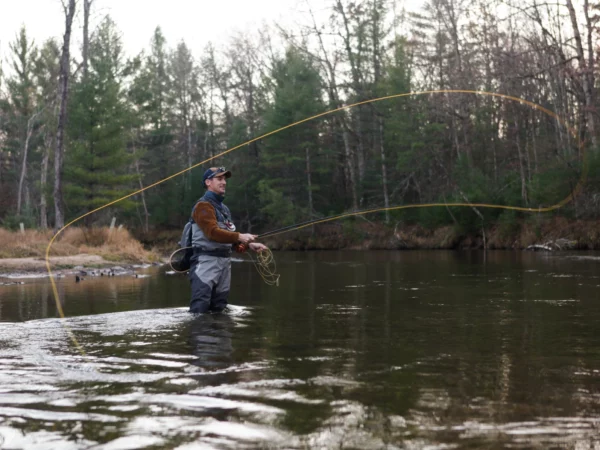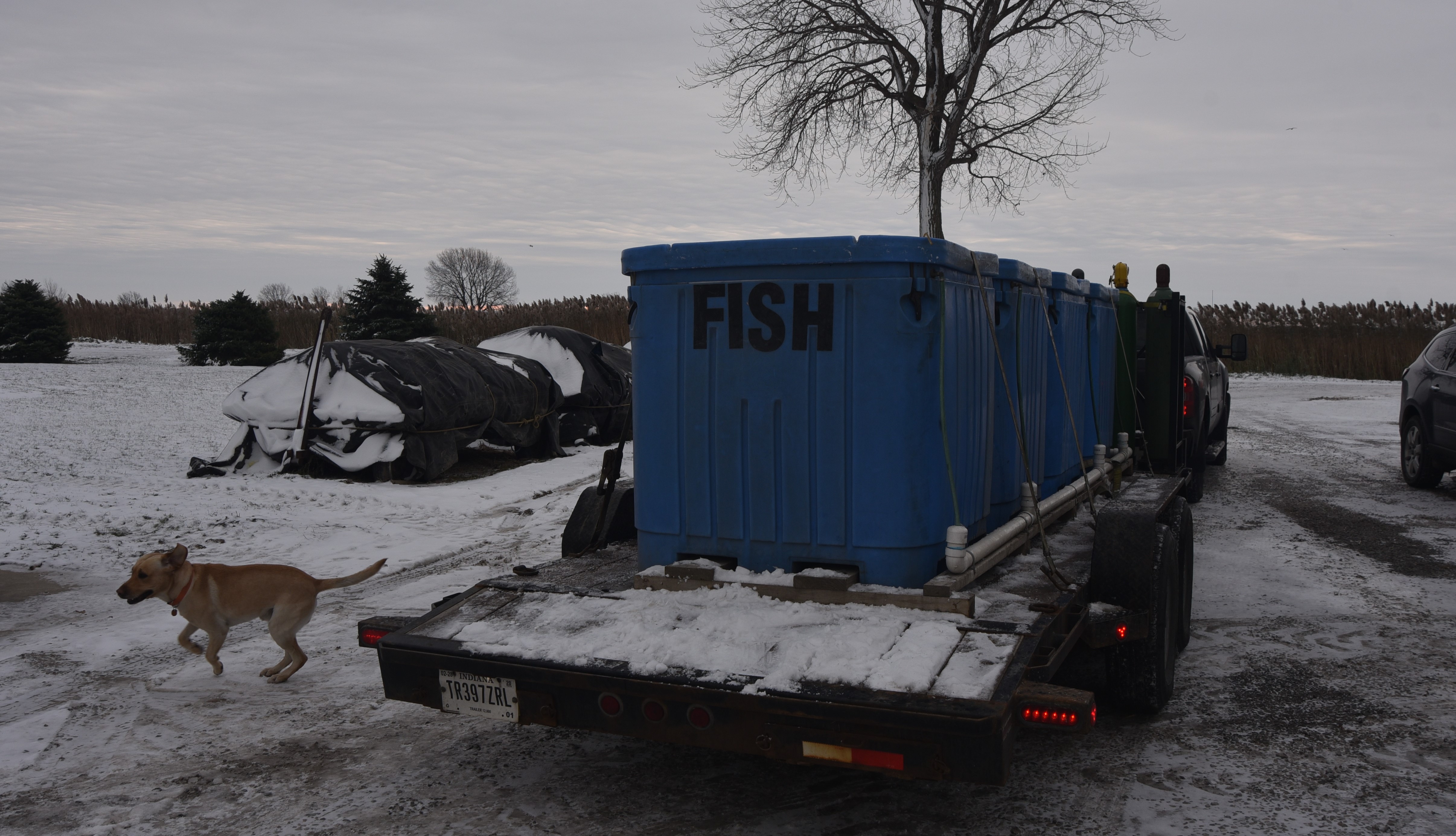
It can be argued that the modern era of commercial fishing began around 1954, when the U.S. and Canada signed a treaty agreeing to work cooperatively to address Great Lakes issues.
One creature was the catalyst that brought them together: the sea lamprey. The Great Lakes Fishery Commission was born.
Ontario and the Great Lakes states began collaborating to solve the sea lamprey problem and share scientific information to preserve and enhance the fisheries.
“It really took the invasion of sea lamprey wiping out lake trout in all the other Great Lakes and then Lake Superior for Canada and the U.S. to sign a treaty,” said Cory Goldsworthy, Lake Superior area fisheries supervisor with the Minnesota Department of Natural Resources.
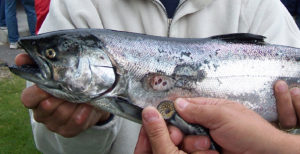
A salmon with sea lamprey wound, Photo by Marc Gaden courtesy of GLFC.
Goldsworthy said it was only through the creation of the Great Lakes Fishery Commission that the lakes as a whole were saved. Before the organization of the commission, each political subdivision managed its portion of the lake independently as it felt its citizens were best served.
“It was through the GLFC on Lake Superior that we were able to save any wild lake trout,” he said. “It was the only Great Lake that retained any wild lake trout from predation.”
Lamprey killed all the wild lake trout except a small population in Lake Superior, which has since recovered. Managers on the other four lakes have seen the fish return with stocking programs and close monitoring and control of lamprey.
Sea lamprey impetus for monumental change
Sea lampreys were documented in Lake Ontario in the 1830s. It’s widely believed they entered from the Atlantic through the Erie Canal, which opened in 1825. Improvements in the Welland Canal, connecting lakes Ontario and Erie in 1919, are believed to have allowed the lamprey to enter Lake Erie. From there it spread to the other three lakes.

An up-close photo of a sea lamprey’s mouth, Photo courtesy of GLFC.
The lamprey population exploded in the late 1940s, nearly wiping out lake trout, whitefish and cisco, then the mainstay of commercial fishing.
According to the GLFC, up to 15 million pounds lake trout were pulled from the upper Great Lakes each year prior to the 1940s. By the early 1960s, the harvest had dropped by 98 percent, to just 300,000 pounds. Among those fish not killed by lamprey, 85 percent bore wounds.
An aggressive control program by GLFC on about 200 lake tributaries now target lamprey young, which spend the first portion of their lives as filter-feeding larvae buried in soft stream beds. The use of several lampricide products—pesticides specifically formulated to lamprey larvae—are regularly used to treat areas where lampreys have spawned. In addition, barriers and traps designed to allow fish but not lamprey passage are also used.
Addressing concerns lake by lake
In the GLFC, each lake is represented by a committee with up to 21 members from the states, Native American tribes and provincial agencies. The committees’ oversight includes invasive species like the sea lamprey, environmental issues, fish stocking and recreational and commercial fishing activities.
Reports generated by committees often track fish populations, harvest data and other trends.
Travis Hartman, a fisheries biologist with the Ohio Department of Natural Resources, is a member of the Lake Erie Committee and says commercial fishing is a closely monitored activity.
“I think we’re probably the highest-tech freshwater fishery in the world. If you follow the history of our Ohio fishery, I think we’re in the most unique period we’ve ever been in with electronic monitoring, our catch reporting,” he said.
In 2008 Ohio began requiring its dozen commercial operators to install GPS tracking aboard vessels. With the devices, which fishermen installed at their own expense, management officials can track fishing activities in real time.
Fishing friction a common theme
Lake Erie, a Great Lakes hotspot for walleye and yellow perch, especially in the Western Basin, is also a hotspot for division, most often between commercial operators and recreational anglers.
“That’s kind of a common thing all over the country, all over the world,” Hartman said of anglers who believe commercial operators take too many fish. “My argument would be that Lake Erie yellow perch are the most-monitored, most-regulated commercial fishery we have. It’s monitored by region, not just lake-wide.”
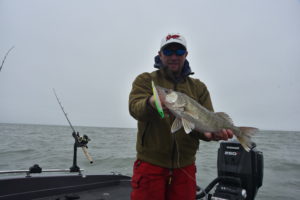
Recreational anglers, like this Lake Erie walleye fisherman, are often at odds with the commercial fishing industry, Photo by James Proffitt
Commercial fishermen in Ohio catch exponentially more rough fish like carp, catfish, white perch, sheepshead and white bass than yellow perch, according to Hartman. And the yellow perch they do catch are limited by a total allowable catch set each year by the Lake Erie Committee, based on species populations and other data.
Great Lakes committees all set TACs for the most desirable and regulated species, then divide those fish into quotas available to each lake state or tribe. The states then divide their fish quotas among its stakeholders.
In Ohio, commercial fishermen may take perch, but not walleye. Ohio’s commercial harvest of walleye ended in the 1970s. Virtually all walleye sold in Ohio are caught by Canadian commercial fishermen north of the border. This works well for Ohio, since recreational anglers see a huge benefit for their fishing endeavors: readily available walleye by the millions.
Ontario’s sport fishing industry is minimal, compared to Ohio’s, and so its walleye TAC is designated almost exclusively to commercial netters.
But in Michigan, TACs for lake trout and walleye are the source of conflict and dueling legislative bills.
Michigan anglers want permanent ban
“We don’t want gamefish in the hands of commercial anglers whether that be targeted catch or bycatch,” said Nick Green, spokesman for Michigan United Conservation Clubs, who went on to express doubts about the lake trout bycatch that commercial fishermen report.
Green said three House Bills, 4567 sponsored by Rep. Jack O’Malley (R-Lake Ann), 4568 sponsored by Rep. Pauline Wendzel (R-Watervliet), and 4569 sponsored by Rep. Jim Lilly (R-Park Township) are companion bills which seek to update commercial fishing regulations. That includes designating yellow perch, walleye and lake trout as game fish, making them illegal for commercial harvest in the future. Those fish are technically eligible for commercial harvest, but current Michigan Department of Natural Resources regulations prohibit commercial harvest of the fish.
Scott Everett, legislative director for the Michigan Commercial Fish Producer’s Association, characterized the three house bills as losers.
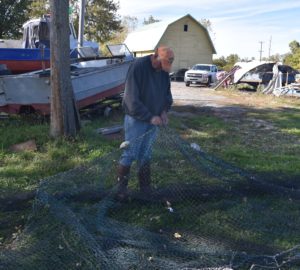
Randy Swartz and other commercial fisherment spend plenty of time on land ending nets, Photo by James Proffitt
“There is not one thing in the bills that’s beneficial to commercial fishing,” he said. “There’s several special-interest groups and this is what they want. And I think the DNR also wants it. Through the past 50 years there’s been seven or eight runs by the DNR to eliminate commercial fishing and now it’s time for them to try again.”
MDNR records indicate that in 1969 there were 339 state-issued commercial fishing licenses and that by 1981 they numbered 120. By 2011 just 51. Currently, just 35 of those are actively utilized.
Everett said that there is actually a science-based need to reduce some fish now, citing an exploding walleye population in Saginaw Bay.
“There is a massive overpopulation. So big that in a presentation I heard the DNR say that sportfishing cannot bring the population under control, that it can’t be done,” he said. “The same thing for lake trout.”
Dave Fielder, an MDNR fisheries research biologist, said while he has made presentations to the Lake Huron Citizen’s Advisors Committee, he didn’t say that recreational anglers couldn’t bring walleye under control.
“The walleye population had been suppressed in Saginaw Bay until the early 2000’s, and it was sustained largely through stocking,” he said. “It was suppressed for a variety of reason, but principally because of impacts from non-native alewives.”
Fielder said natural reproduction for walleye exploded after the alewife population collapsed, since the fish preys heavily on larval walleye.
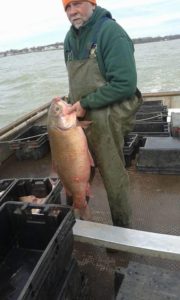
Commercial fisherman Randy Swartz aboard one of his vessels, Photo courtesy of Randy Swartz
“The walleye population met our recovery targets in 2009 and we discontinued stocking in 2006,” he said. “Today it’s a fully wild, self-sustaining population. It’s been a tremendous boon to recreational fishing opportunities.”
Everett pointed out that the very fish MCFPA members can’t catch are free to swim into Canadian waters, where they are caught and sold in the U.S.
Michigan’s commercial fleet currently harvests a large number of lake trout as bycatch, he said. But MDNR regulations require they be released immediately – and when they are thrown back, many subsequently die, wasted, he added.
Senate Bill 389 introduced by Sen. Kevin Daley (R-Lum) and co-sponsored by Sen. Ed McBroom (R-Vulcan) and House Bill 4790 introduced by Rep. Sara Cambensy (D-Marquette), both offer support for the industry. Reps. Beau LaFave (R-Iron Mountain) and Greg Markkanen (R-Hancock) are co-sponsoring HB 4790, which would open up bycatch and a small amount of game fish to possible catch in the future, should MDNR rules change.
H.B. 4790 commercial-friendly laws would establish a commercial fishing advisory panel to help oversee the industry and offer increased penalties for violators.
“I’m happy to sponsor a bill that modernizes our commercial fishing regulations and supports an important, long-standing industry in our state,” Cambensy said in a news release.
Recreational anglers pay for fisheries management
But Green said sport fishermen alone pay for Michigan’s fisheries management and operations.
“For decades and decades, it’s really been the North American model of conservation, where hunters and anglers, and in this case especially anglers, through their fishing licenses fund habitat, fund fish planting and fund management,” he said. “Purchases of reels, rods and equipment fund it through the Dingell-Johnson Act.”
The law, also called the Federal Aid in Sport Fish Restoration Act, is an excise tax paid on certain fishing and hunting merchandise, which is divided among states each year. The annual fees paid by Michigan’s commercial operators don’t even cover the cost of commercial regulation, according to Green.
“MUCC commissioned a study released in January studying the effects of hunting and fishing in Michigan. We found that sport anglers spend about $2.1 billion annually on fishing. And the commercial fishing industry is something like $150 million, the money it brings in,” Green said. “So it’s pretty easy to see the value of sport fishing in Michigan.”
Fishmonger’s wife: Commercial fishing is important too
Amber Petersen’s husband Eric is a fourth-generation commercial fisherman out of Muskegon. She operates The Fishmonger’s Wife, a retail fish store while he catches the fish.
“We have a saying: Amber stays on land and Eric goes out on the boat and everybody’s happy,” she said, laughing. “Whitefish is 99 percent of what we catch. They’re delicate and flaky and have a very mild flavor. It’s definitely a go-to fish and restaurants love it because it appeals to a lot of palates.”
Petersen vehemently defends commercial fishing in Michigan, scoffing at the idea that operations like theirs would visit destruction on the state’s fisheries.

Mending nets on a nice day, Photo by James Proffitt
“The fish we’re looking at are lake trout, walleye and yellow perch and those have been commercially fished since Michigan became a state,” she said. “The reality is there are only 13 of us left. Thirteen commercial fishing operations and we’re going to steal someone else’s fish? Bologna.”
“Whatever happens next will be Lansing’s call,” Petersen said. “It’s down to the legislature working and hashing it out. I really wish I had a crystal ball.”
Everett said commercial operators only seek a small piece of the pie—a 10 percent quota of Michigan’s TAC for lake trout and 20 percent for walleye.
“We’re talking about lake trout that are already being caught and thrown back and dying,” he said. “In S.B. 389 we want to establish a process based on quotas, based on sound scientific estimates of fish populations through data gathering and analysis.”
Everett said the trio of fishing bills restricting commercial fishing have left the House Natural Resources Committee and are now with the House Ways and Means Committee. He expects they’ll move to the house floor for a vote where they could pass, but said friendly votes in the senate will hopefully prevent the bills from going to Gov. Gretchen Whitmer. According to Everett, she would likely sign legislation restricting future commercial fishing endeavors, deferring to her MDNR staff.
“That’s her agency, these are her people,” Everett said. “And so when you got the agency where they’re at, yeah, the MDNR’s position is her position.”
Room for both
Fishing culture changed around the ‘50s and ‘60s with overfishing and sea lamprey impacting the commercial industry, and post-World War II when people had more leisure time and disposable income, according to Marc Gaden, communications director and legislative liaison for the GLFC.
“More small boats, more people getting out there with more time and money to do it,” he said.
The introduction of salmon to the lakes in the 1960s boosted the recreational fishing industry in a big way, in conjunction with states actively managing for the recreational fishing industry, he said.
“But with all that said, the commercial fishing industry is still worth hundreds and hundreds of millions of dollars and there are communities throughout the Great Lakes Basin that really thrive on commercial fishing,” Gaden said. “And certainly in Ontario, the commercial fishing industry is far, far bigger than the recreational industry.”
Great Lakes doing well overall
Gaden described the current state of the Great Lakes fisheries in positive terms when asked to describe the difference between now compared to the 1950s and earlier.
“Oh goodness, yes, it’s better,” he exclaimed. “It’s a $7 billion fishery and, compared to the 1940s, there’s been a shift from the commercial value to the recreational value. Since the lakes were cleaned up, beginning in the early 1970s with the Great Lakes Water Quality Agreement and then with lamprey control which began in 1957, the conditions in the lakes are not what they were in the 1940s when there was overfishing and lamprey predation and pollution and habitat loss.”
We still have problems today, which include Asian carp, climate change, algal blooms and nutrients loading, Gaden said, and they are not insignificant.
“But at least there are regulations,” he said. “Back in the 1940s the states and Ontario were all over the place in regards to regulating the fishery. So we’re in a very different place.”
Featured Image: Truckload of live catfish is headed to fish markets in the Midwest, Photo by James Proffitt
Read the first part of this series, on the history of the fishing industry in the Great Lakes, here:
![]() Great Lakes Fishery: The start of the industry and the fall of fish populations
Great Lakes Fishery: The start of the industry and the fall of fish populations
2 Comments
-
FYI. The picture in this article identified as Commercial fisherman Randy Swartz titled ” The Walleye is a Carp not a Walleye
-
Angler license fees do go for conservation of species for the purchased areas. However in the numbers game “money” commercial fisheries pay more towards taxes and less towards conservation of the species being caught. Should there be an adjustment to the taxes that are being paid or should I show myself the door?



